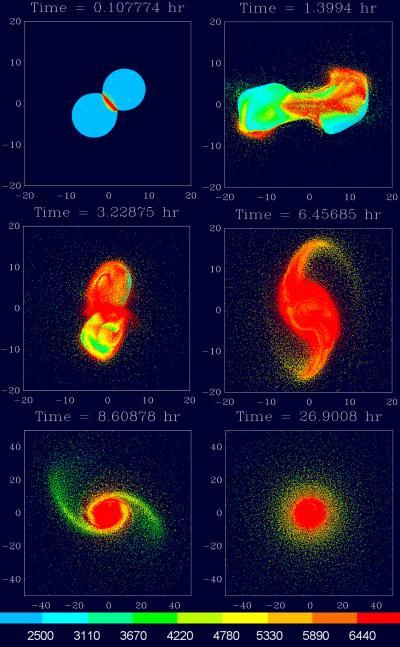The giant impact believed to have formed the Earth-Moon system has long been accepted as canon. However, a major challenge to the theory has been that the Earth and Moon have identical oxygen isotope compositions, even though earlier impact models indicated they should differ substantially. In a paper published today in the journal Science online, a new model by Southwest Research Institute (SwRI), motivated by accompanying work by others on the early dynamical history of the Moon, accounts for this similarity in composition while also yielding an appropriate mass for Earth and Moon.
In the giant impact scenario, the Moon forms from debris ejected into an Earth-orbiting disk by the collision of a smaller proto-planet with the early Earth. Earlier models found that most or much of the disk material would have originated from the Mars-sized impacting body, whose composition likely would have differed substantially from that of Earth.
The new models developed by Dr. Robin M. Canup, an associate vice president in the SwRI Space Science and Engineering Division, and funded by the NASA Lunar Science Institute, involve much larger impactors than were previously considered. In the new simulations, both the impactor and the target are of comparable mass, with each containing about 4 to 5 times the mass of Mars. The near symmetry of the collision causes the disk's composition to be extremely similar to that of the final planet's mantle over a relatively broad range of impact angles and speeds, consistent with the Earth-Moon compositional similarities.
The new impacts produce an Earth that is rotating 2 to 2.5 times faster than implied by the current angular momentum of the Earth-Moon system, which is contained in both the Earth's rotation and the Moon's orbit. However, in an accompanying paper in Science, Dr. Matija Ćuk, SETI Institute, and Dr. Sarah T. Stewart, Harvard University, show that a resonant interaction between the early Moon and the Sun — known as the evection resonance — could have decreased the angular momentum of the Earth-Moon system by this amount soon after the Moon-forming impact.
"By allowing for a much higher initial angular momentum for the Earth-Moon system, the Ćuk and Stewart work allows for impacts that for the first time can directly produce an appropriately massive disk with a composition equal to that of the planet's mantle," says Canup.
In addition to the impacts identified in Canup's paper, Ćuk and Stewart show that impacts involving a much smaller, high-velocity impactor colliding into a target that is rotating very rapidly due to a prior impact can also produce a disk-planet system with similar compositions.
"The ultimate likelihood of each impact scenario will need to be assessed by improved models of terrestrial planet formation, as well as by a better understanding of the conditions required for the evection resonance mechanism," adds Canup.

Shown is an off-center, low-velocity collision of two protoplanets containing 45 percent and 55 percent of the Earths mass. Color scales with particle temperature in kelvin, with blue-to-red indicating temperatures from 2,000 K to in excess of 6,440 K. After the initial impact, the protoplanets re-collide, merge and form a rapidly spinning Earth-mass planet surrounded by an iron-poor protolunar disk containing about 3 lunar masses. The composition of the disk and the final planets mantle differ by less than 1 percent.
(Photo Credit: Southwest Research Institute)

Shown is an off-center, low-velocity collision of two protoplanets containing 45 percent and 55 percent of the Earth's mass. Color scales with particle temperature in kelvin, with blue-to-red indicating temperatures from 2,000 K to in excess of 6,440 K. After the initial impact, the protoplanets re-collide, merge and form a rapidly spinning Earth-mass planet surrounded by an iron-poor protolunar disk containing about 3 lunar masses. The composition of the disk and the final planet's mantle differ by less than 1 percent.
(Photo Credit: Southwest Research Institute)
Source: Southwest Research Institute